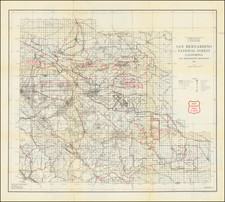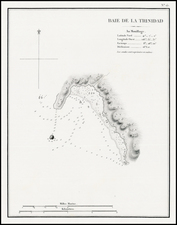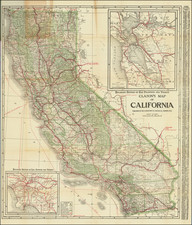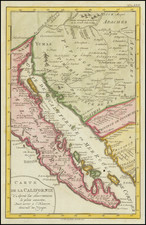Rare early petroleum map of the Santa Barbara area--With Speculator's Annotations Regarding the Father of the Port of Los Angeles
Intriguing and informative map of the California coast between Santa Barbara and Los Angeles with a focus on petroleum extraction. The map shows the coastline from Point Concepcion in the north to San Pedro in the south at a scale of six miles to the inch.
The map denotes ranchos naming property owners and acreage. An inset map in the lower-left focuses on the Ojai Rancho, with various marked "oil springs." This inset was compiled from surveys conducted in 1864. The channel islands can be seen off the coast of Santa Barbara.
As noted by the important California collector Warren Heckrotte:
This is the second pamphlet and the second by Silliman dealing with oil in California; and the map is regarded as the first to show oil deposits in California.
While Heckrotte's assertion may be true, the Doolittle 1865 map of Humboldt County also shows oil and gas deposits.
This is the earliest printed map listed in OCLC to focus on Ojai.
Manuscript Annotations
This example of the map includes manuscript annotations, along with an outline of an area south of the Santa Clara River to Point Magu, roughly corresponding with the southern part of Ventura County, which read as follows:
Banning's schemes proposes to gobble up about 300.000 acres of land-as follows... [with all or part of a large portion of a number of Ranchos in today's Ventura County]
Numerous plots are then listed, summing up to a total to 287,000 acres, with several revisions. The plots and ranchos named are all in the Ventura and Oxnard areas.
This almost certainly refers to Phineas Banning, one of the founding fathers of Wilmington (in the southern part of this map) and an important investor in the area. Having arrived in San Pedro in 1851 as a 21-year-old, he worked his way to starting his own staging and shipping company. By the 1860s, Banning was wealthy enough to purchase land in the Wilmington area and jumpstart the growth of one of the world's largest ports. The town of Banning, CA, and its namesake pass are named after him.
The exact details of this scheme are unknown. In 1865, Banning was primarily focused on building a railroad from the city of Los Angeles to his port in Wilmington. However, the agricultural and industrial economy of Ventura County was growing at the time, and Banning was perhaps interested in purchasing land to expand his business empire. However, there is no record that he went through with this scheme, and his focus apparently shifted towards Catalina Island, which his family would later buy.
Benjamin Silliman Jr. (1816-1885) was a significant figure in 19th-century American science, renowned for his contributions to chemistry and geology, notably in the burgeoning field of petroleum science. The son of a famed chemist and professor at Yale College, Benjamin Silliman Sr., he followed in his father's footsteps and carved out his own distinguished academic and scientific career. Graduating from Yale in 1837, he later became a professor of chemistry at the same institution, where he was instrumental in developing its scientific curriculum and facilities.
Silliman Jr. is perhaps best remembered for his pioneering work in the oil and petroleum industries in the United States. His analytical skills were showcased in 1855 when he conducted one of the first scientific studies of crude oil. Commissioned by the Pennsylvania Rock Oil Company, his work provided a comprehensive chemical analysis of petroleum and helped stimulate the first American oil boom by highlighting oil's potential uses in illumination and lubrication. His report became a cornerstone in the development of the petroleum industry, demonstrating the economic viability of rock oil.
Aside from his scientific pursuits, Silliman Jr. also made notable contributions to the popularization of science through his editorship of the American Journal of Science, founded by his father. His efforts in science education and communication, coupled with his pioneering studies in petroleum, cemented his legacy as a key figure in American science during a period of rapid industrial and technological transformation.

![[ California Petroleum ] A Description of the Recently Discovered Petroleum Region in California. With a Report on the Same [with:] Map Representing Locality of The Ojai Ranch in Santa Barbara County, California, belonging to the California Petroleum Company 1865 By Benjamin Silliman, Jr.](https://storage.googleapis.com/raremaps/img/small/103844.jpg)








![[ California To Alaska -- Northwest Passage ] Quivirae Regnu cum alijs versus Borea](https://storage.googleapis.com/raremaps/img/small/60083.jpg)
![Mexico [Texas on the Eve of Independence]](https://storage.googleapis.com/raremaps/img/small/84917.jpg)



